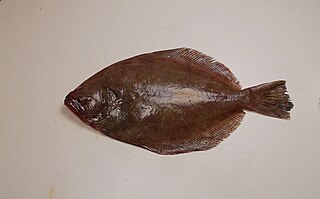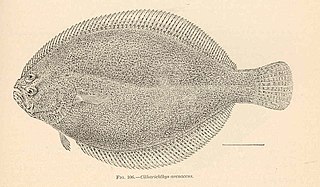
Citharichthys is a genus of flatfish in the large-tooth flounder family, Paralichthyidae. They have both eyes on the left sides of their heads. They are native to the oceans around the Americas, with a single species, C. stampflii off the West African coast. Most are found in relatively shallow depths, but the genus also includes species found in deep water and species that enter fresh water.

Large-tooth flounders or sand flounders are a family, Paralichthyidae, of flounders. The family contains 14 genera with a total of about 110 species. They lie on the sea bed on their right side; both eyes are always on the left side of the head, while the Pleuronectidae usually have their eyes on the right side of the head.

The summer flounder or fluke is a marine flatfish that is found in the Atlantic Ocean off the East Coast of the United States and Canada. It is especially abundant in waters from North Carolina to Massachusetts.

Paralichthys lethostigma, the southern flounder, is a species of large-tooth flounder native to the East Coast of the United States and the northern Gulf of Mexico. It is a popular sport fish and is the largest and most commercially valuable flounder in the western North Atlantic Ocean and Gulf of Mexico. It is a "left-eyed flounder", meaning the left side is pigmented and is the "up side".

Hippoglossina oblonga, is a flatfish and member of the large-tooth flounder family Paralichthyidae. This species has been placed in the genus Paralichthys by some authorities.

Tephrinectes sinensis, the Chinese brill, is a species of flatfish in the large-tooth flounder family, Paralichthyidae. It is the only member of its genus Tephrinectes. Like the rest of the large-tooth flounders, it has both eyes on the left side of its head.
Thysanopsetta naresi is a species of flatfish in the large-tooth flounder family, Paralichthyidae. It is the only member of its genus Thysanopsetta. Thysanopsetta naresi is a demersal fish that lives in temperate waters at depths of between 90 and 170 metres. It can be found in the southeast Pacific Ocean, off the coast of Chile, and in the southwest Atlantic Ocean in Patagonia and in the Falkland region. It grows to around 15.1 centimetres (5.9 in) in length.
Pseudorhombus quinquocellatus, the five-eyed flounder, is a species of flatfish in the large-tooth flounder family, Paralichthyidae. It is a demersal fish that lives in tropical waters, inhabiting deep waters on the continental shelf of the western Pacific Ocean, from Taiwan in the north to Australia in the south.
Citharichthys gordae, the mimic sanddab, is a species of sanddab in the large-tooth flounder family Paralichthyidae. It is native to the eastern Pacific Ocean, found off the coast of Mexico. It has a limited distribution, found in the Magdalena Bay and along the Baja California peninsula, as well as part of the Gulf of California.
Citharichthys platophrys, the small sanddab, is a species of sanddab in the large-tooth flounder family Paralichthyidae. It is native to the eastern Pacific Ocean, ranging from the southern Gulf of California of Mexico in the north to Peru in the south.

Etropus rimosus, the gray flounder, is a species of flounder in the large-tooth flounder family Paralichthyidae. It is native to the western Atlantic Ocean, ranging from the coast of North Carolina to the south of Florida. It can also be found in the eastern Gulf of Mexico.
Citharichthys gymnorhinus, the anglefin whiff, is a species of flatfish in the large-tooth flounder family Paralichthyidae. It is a demersal marine fish that inhabits the mid to outer continental shelf of the western Atlantic Ocean, in both tropical and subtropical waters. It ranges from the Bahamas and Florida in the north to Guyana and Nicaragua in the south, though larvae samples have also been collected off the coast of Canada. It occurs at depths between 35 and 200 metres, but is most commonly found in shallower waters.
Citharichthys gilberti, the bigmouth sanddab, is a species of flatfish in the large-tooth flounder family Paralichthyidae. It is native to the eastern Pacific Ocean, in tropical waters ranging from the Gulf of California in the north to Peru in the south. It occurs in shallow waters off the coast, to a maximum depth of 36 m (118 ft).
Citharichthys mariajorisae, the five-rayed sanddab, is a species of flatfish in the large-tooth flounder family Paralichthyidae. It is native to the eastern Pacific Ocean, in tropical waters ranging from the Gulf of California in the north to the Bay of Panama in the south. It is a demersal marine fish, inhabiting the sandy bottoms of shallow coastal waters at a depth between 10 and 45 metres.
Citharichthys xanthostigma, the longfin sanddab, is a species of flatfish in the large-tooth flounder family Paralichthyidae. It is native to the eastern Pacific Ocean, in subtropical waters ranging from Monterey Bay, California in the north, to Costa Rica in the south. It is a demersal marine fish, and can be found on the soft bottoms of coastal waters at depths between 2 and 201 metres.
Citharichthys abbotti, the Veracruz whiff, is a species of flatfish in the large-tooth flounder family Paralichthyidae. It is endemic to the southwestern Gulf of Mexico, found on the Eastern Mexico Continental Shelf, with Veracruz to the south and the Rio Grande to the north.
Citharichthys amblybregmatus is a species of flatfish in the large-tooth flounder family Paralichthyidae. It is native to the western north Atlantic Ocean. It has been collected at a depth of 198 m (650 ft).

Citharichthys arenaceus, the sand whiff, is a species of flatfish in the large-tooth flounder family Paralichthyidae. This demersal marine fish inhabits the western Atlantic Ocean, occurring in shallow tropical coastal waters, as well as in estuaries, bays, and lagoons. It ranges from Florida, United States, in the north to the West Indies and Brazil in the south.

The bay whiff is part of the family Paralichthyidae. This family is known as "left-eye flounders". They are one of the most common flatfish of the Gulf of Mexico. They are benthic ambush predators with the ability to camouflage themselves on or just below the surface. They are often solitary animals with few individuals. They vary in color from light to dark in life and are brownish in color after death. They have two dark spots on the caudal peduncle and a light spot under the pectoral fin. The average size of the Bay whiff is 15 cm and the maximum recorded length is 20 cm. The lateral line is straight along the body. It has a large mouth. The opercle on the blind side has no cirri. Their pelvic fins are also asymmetrical.

The Gulf Stream flounder is a species of fish belonging to the family Paralichthyidae native to waters off eastern North America.









